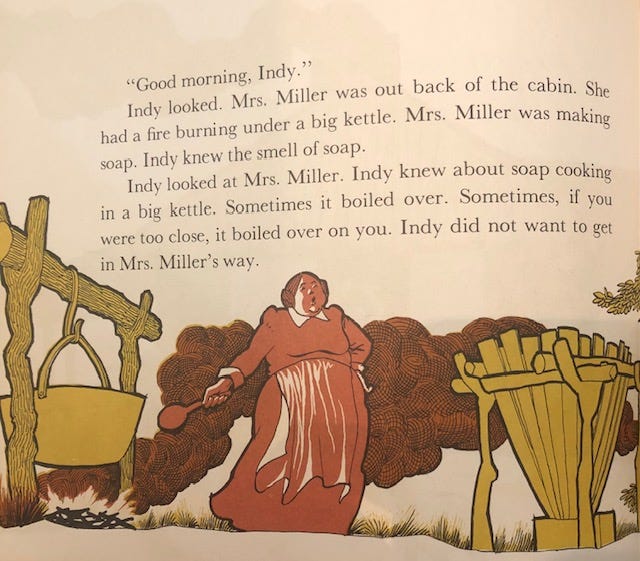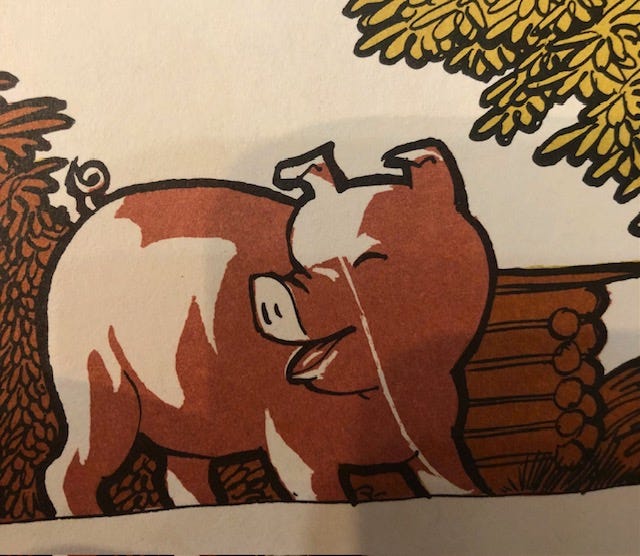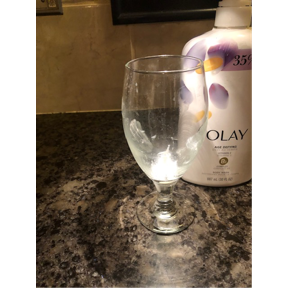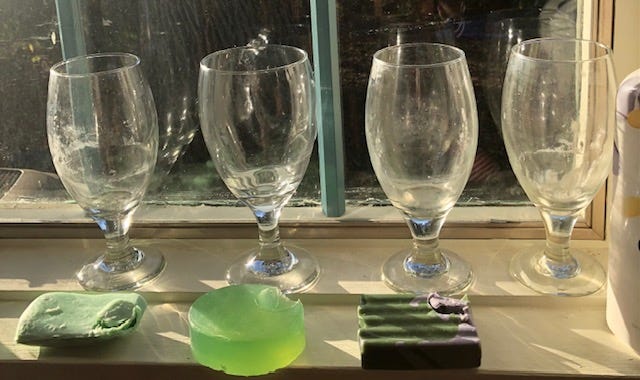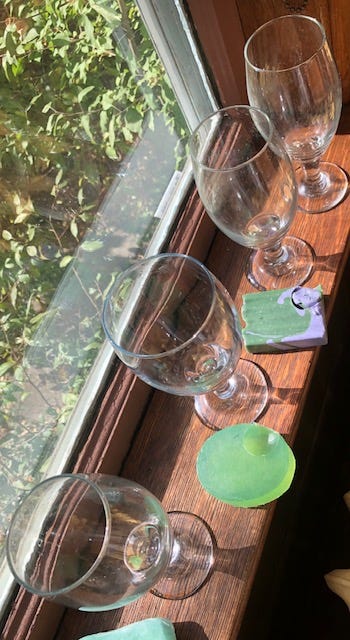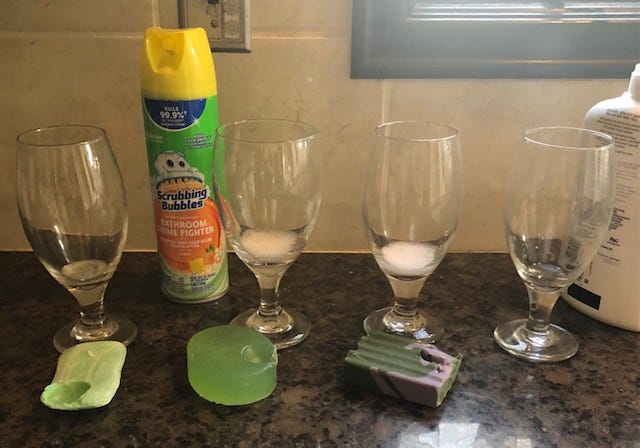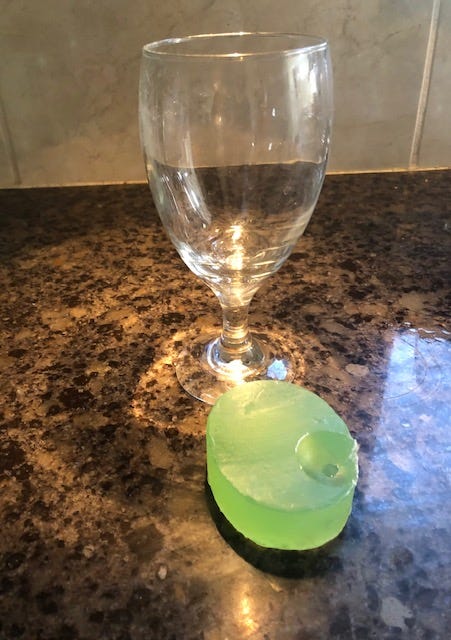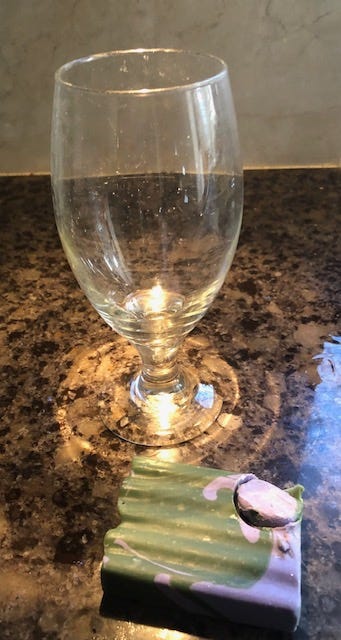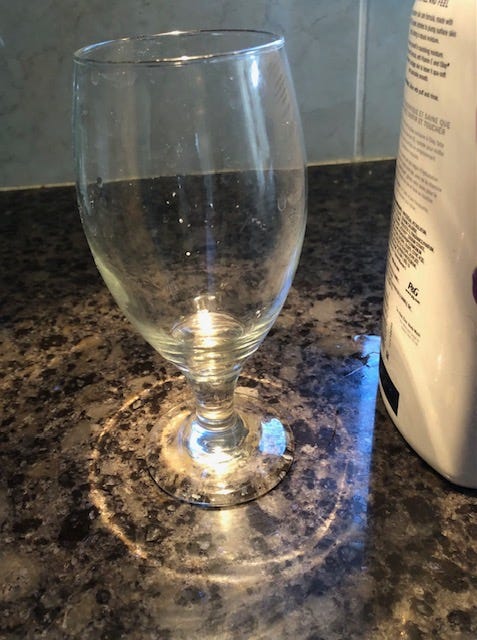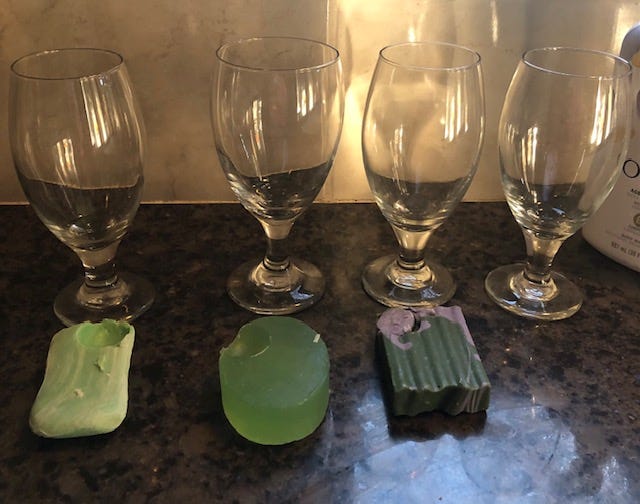A while back I got a question about soap. Specifically, what kind is best in hard water so as not to leave a scum? A quick reading said glycerin soap, but it seemed easy enough to test. I set up my own experiment with regular soap, glycerin soap, vegetable soap with goat milk, and body wash. I placed a half tablespoon of each into separate glasses and then added ¼ cup of mineral water to each. The mineral water contained 345 ppm calcium and 100 ppm magnesium. This gave a total hardness of 445 ppm, considered very hard. Minerals in water react with soaps to form scum.
The pH of the water was 8.4 which is alkaline.
Ten minutes in: differences are noticeable.
To make soap you need to mix fat and an alkali, usually lye. Here is an illustration of soap making from the old children’s book Indy and Mr. Lincoln.
Here’s Indy by the way:
Different types of soaps may have different fats in the kettle so to speak. In the case of my experiment, the “regular soap” was made from a combination of tallow, palm oils and many other things including glycerin, which is a by-product of soap making.
The goat milk soap was made from olive oil, castor oil coconut, and palm oils in goat milk. Castile soap may also be made from olive oil but isn’t always 100% olive oil. Check the label.
Glycerin soap has glycerol for its fat. Glycerol is a smaller molecule than the other fats and is related to “triglycerides.”
Here’s a list of fats used in soap making for those interested.
Body wash works the same as soap but it isn’t made from fat and lye. It’s derived from oil, palm or coconut usually, and is chemically modified. Since it is sold as a liquid, body wash can have added moisturizers and be pH adjusted. However, bar soap is more compact and has less plastic waste. There really is no best product.You need to use what works for you. If what works for you is the one that leaves the least scum, read on!
I let the soaps sit for five hours. They looked like this:
I filtered each glass. I was going to compare the amount of soap retrieved from each glass but the glycerin soap had fully dissolved. I let the glasses dry for three hours and then took a photo of each.
Here is the regular, conventional soap (Irish Spring) with the remaining soap returned to its divot. You can see the familiar soap scum ring.
Here is the glycerin bar. It has a filmy layer of deposit.
Next is the goat milk Zum Bar (above). The plant-based soap left a deposit.
The body wash left a sludge.
My next step was to clean each glass. Getting rid of soap scum means making it soluble. I added a ¼ cup of water to each glass, swirled it around, and let it sit for the length of a shower, 10 minutes. The water had a pH of 8 and a hardness of 100 (low). I tested the pH of the water and scum. Only the body wash had an acidic pH of 6.8. Your skin likes the pH to be around 5.5 and no higher than 8, which means the body wash has a slight win on this one. The glycerin soap had a pH of 7.4 (7 is neutral) and the other two soaps had a pH of 8.
I let each glass dry.
Here they are (below) in my sunny window. The traditional soaps still have their soap scum with the Irish Spring “regular” soap having the most visible ring. The body wash still looks very slimy.
Next, I added a half of a cup of vinegar to each glass and let it sit for ten minutes. Following this, I rinsed with water and gave each a perfunctory scrub with a brush, trying to clean the crusty spots but not going overboard, because who wants to spend countless minutes scrubbing soap scum? The conventional soap and glycerin soap seemed easiest to clean. Here are the results:
For the last test, I squirted each glass with bathroom cleaner which said it removed 100% of soap scum. Each glass got two squirts and sat for ten minutes. The body wash obliterated the scrubbing bubbles.
Next, I added a half cup of water and let it sit for ten minutes. After that, I scrubbed the glasses and rinsed them. Here are the results, with a little bit of glass sparkle tossed in.
The “regular soap” still has some residue.
The glycerin soap has a little scum near the top but much of the glass is sparkling clean.
The goatmilk soap has some scum.
The body wash had some residue.
For the last step, I rinsed all glasses in the dishwasher (without soap but with a rinse aid) for 20 minutes.
They all came out looking clean.
If I study the photos, I’d have to agree that the glycerin soap left the least scum and the conventional soaps the most. However, soap scum is inevitable. My advice would be to keep your bar soap as dry as you can between usage because it will dissolve, especially glycerin, and as it dissolves, scum will form.
This experiment wasn’t quantitative enough to make me fully happy with it. I’d considered weighing the glasses before and after scumming them, but I don’t think the conventional kitchen scales would have caught the differences. Plus, glass can attract water from the air so I would have had to dry them in the oven before and after to get a proper weight. If I had a lab, I’d do this. Or if you have a lab, you can try it.
For those still curious about soap scum and soap, keeping reading.
Remember the old chemist adage, like dissolves like? A soap molecule can go both ways. It has a long greasy tail and a charged head. Think of it as organic and inorganic combined. The head helps the molecule dissolve in water and the tail lifts away the grease and grime from your skin. (illustration here). But here lies the scum problem.
Soap scum was discussed in a long scholarly article.
Itsadanont, Sawwalak, et al. "Dissolution of Soap Scum by Surfactant Part I: Effects of Chelant and Type of Soap Scum." Journal of Surfactants and Detergents, vol. 17, no. 5, 2014, pp. 849-857
It forms when the calcium and magnesium in the water—the minerals that make the water hard--make a complex with the soap’s charged head. They are charged, they are ions, and they hook up with the charged head of the soap molecule and make it less attracted to the water because the head now has them to hang with. The attraction is undeniable!
This can be prevented by water softening, which removes calcium and magnesium ions and replaces them with sodium ions. Sodium ions don’t hang on so tightly. They like to stay in the water. They won’t make insoluble scum. But soft water is high sodium and low mineral. You really don’t want to be drinking high sodium-low mineral water, so a softner for just the shower would be the key to using this tactic.
Soap scum can be cleaned with vinegar or other pH lowering product, with a surfactant (a cleaning agent), or with a chelating agent. Chelating agents work by stealing away the calcium and magnesium from the scum. However, they only work well at a high pH and this isn’t useful for household products.
In the 90s there was a flurry of products released to keep soap scum from forming and sticking to showers and tubs. They didn’t work great, the interest died down ,and nothing new seems to be forthcoming. I did learn that ants will eat soap scum!
Machosky, Michael. "Keep tiny pests from becoming space invaders." Tribune - Review / Pittsburgh Tribune - Review, Jun 10, 2006.
If I was being a prudent scientist, I’d repeat the experiment. But this scummy tale is getting long enough! Perhaps everyone reading can try a similar experiment and report back.
This blog was in response to a reader’s question about soap scum and hard water. Thanks for asking!




